The Intel Optane Memory (SSD) Preview: 32GB of Kaby Lake Caching
by Billy Tallis on April 24, 2017 12:00 PM EST- Posted in
- SSDs
- Storage
- Intel
- PCIe SSD
- SSD Caching
- M.2
- NVMe
- 3D XPoint
- Optane
- Optane Memory
Random Read
Random read speed is the most difficult performance metric for flash-based SSDs to improve on. There is very limited opportunity for a drive to do useful prefetching or caching, and parallelism from multiple dies and channels can only help at higher queue depths. The NVMe protocol reduces overhead slightly, but even a high-end enterprise PCIe SSDs can struggle to offer random read throughput that would saturate a SATA link.
Real-world random reads are often blocking operations for an application, such as when traversing the filesystem to look up which logical blocks store the contents of a file. Opening even an non-fragmented file can require the OS to perform a chain of several random reads, and since each is dependent on the result of the last, they cannot be queued.
These tests were conducted on the Optane Memory as a standalone SSD, not in any caching configuration.
Queue Depth 1
Our first test of random read performance looks at the dependence on transfer size. Most SSDs focus on 4kB random access as that is the most common page size for virtual memory systems and it is a common filesystem block size. For our test, each transfer size was tested for four minutes and the statistics exclude the first minute. The drives were preconditioned to steady state by filling them with 4kB random writes twice over.
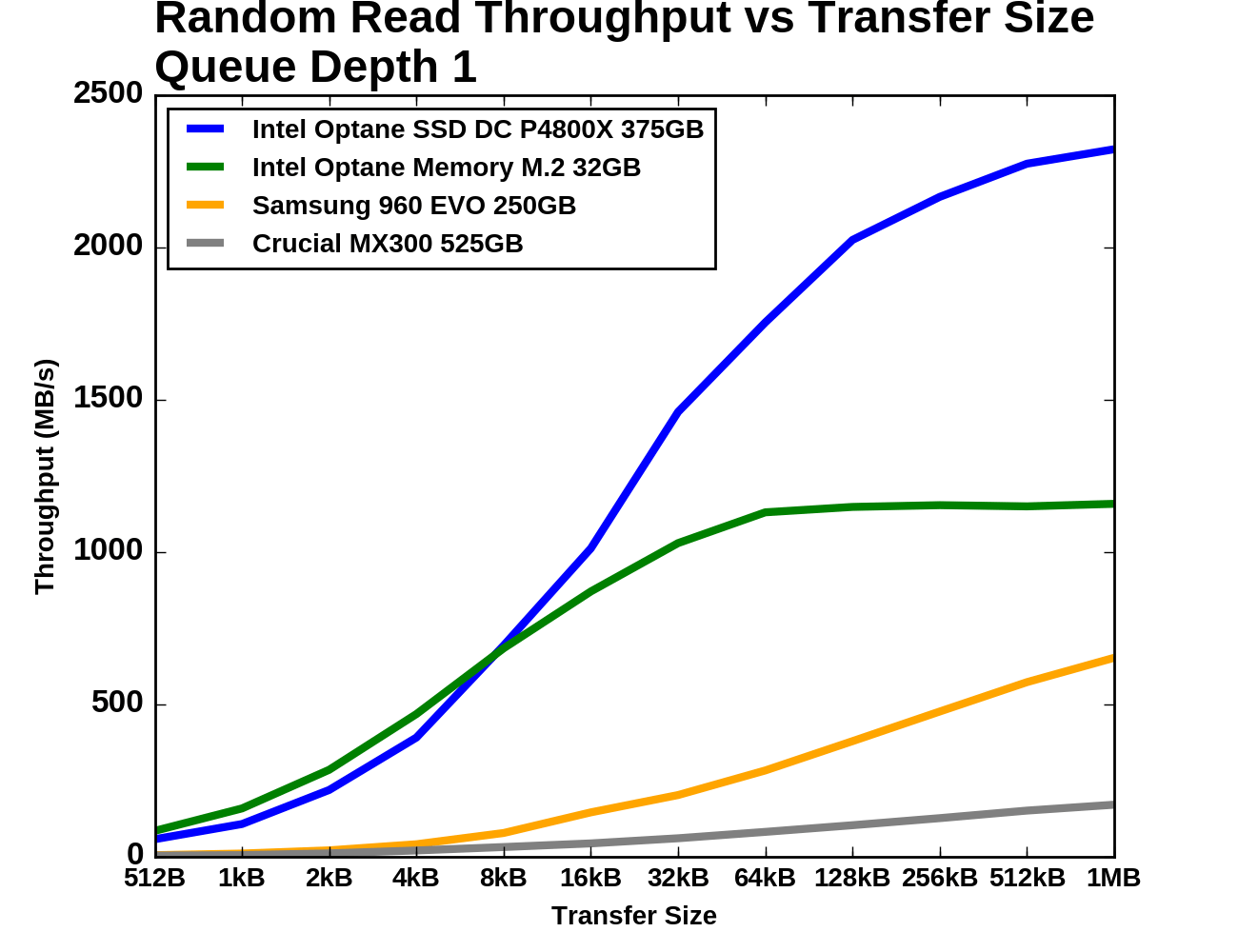 |
|||||||||
| Vertical Axis scale: | Linear | Logarithmic | |||||||
The Optane Memory module manages to provide slightly higher performance than even the P4800X for small random reads, though it levels out at about half the performance for larger transfers. The Samsung 960 EVO starts out about ten times slower than the Optane Memory but narrows the gap in the second half of the test. The Crucial MX300 is behind the Optane memory by more than a factor of ten through most of the test.
Queue Depth >1
Next, we consider 4kB random read performance at queue depths greater than one. A single-threaded process is not capable of saturating the Optane SSD DC P4800X with random reads so this test is conducted with up to four threads. The queue depths of each thread are adjusted so that the queue depth seen by the SSD varies from 1 to 16. The timing is the same as for the other tests: four minutes for each tested queue depth, with the first minute excluded from the statistics.
The SATA, flash NVMe and two Optane products are each clearly occupying different regimes of performance, though there is some overlap between the two Optane devices. Except at QD1, the Optane Memory offers lower throughput and higher latency than the P4800X. By QD16 the Samsung 960 EVO is able to exceed the throughput of the Optane Memory at QD1, but only with an order of magnitude more latency.
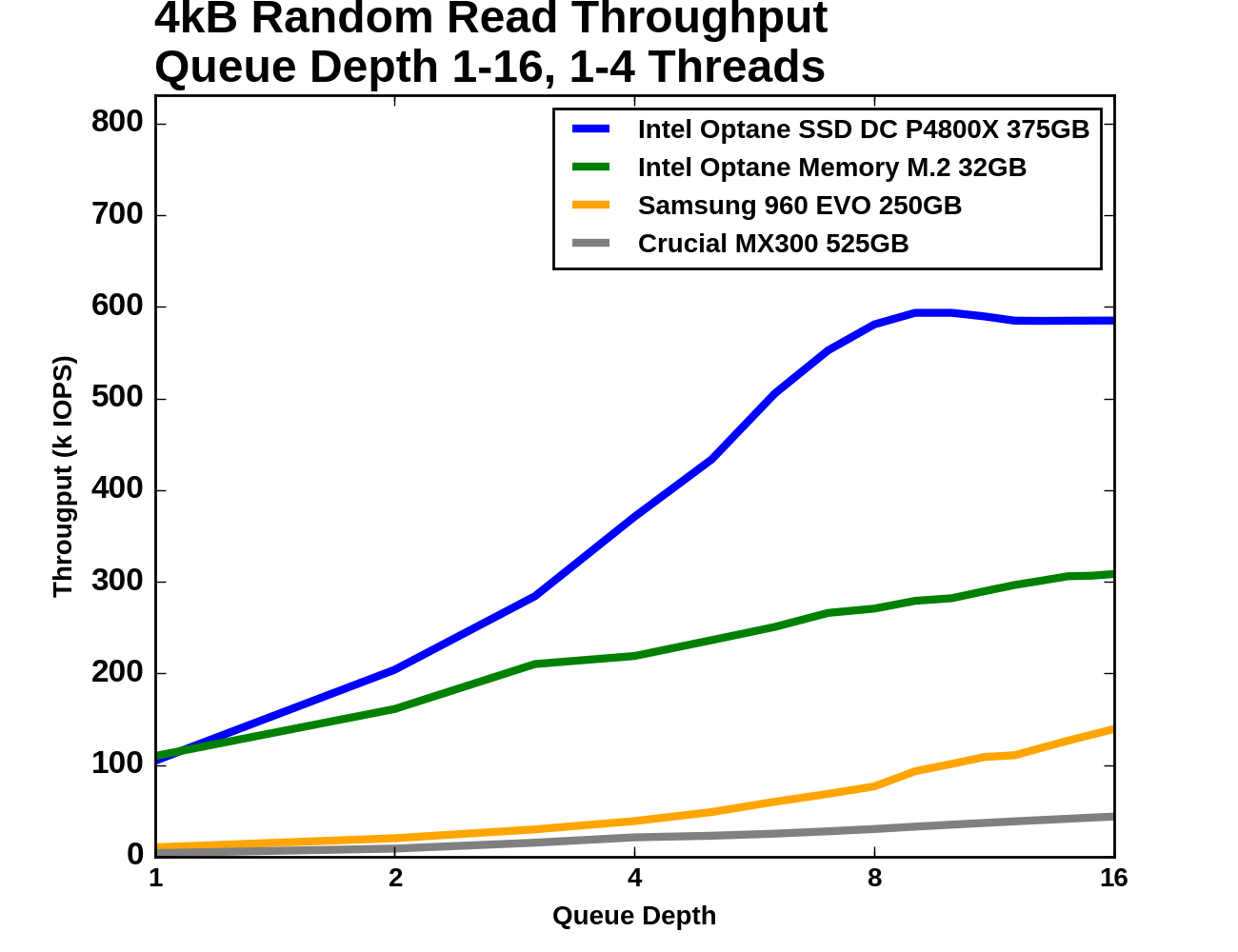 |
|||||||||
| Vertical Axis scale: | Linear | Logarithmic | |||||||
Comparing random read throughput of the Optane SSDs against the flash SSDs at low queue depths requires plotting on a log scale. The Optane Memory's lead over the Samsung 960 EVO is much larger than the 960 EVO's lead over the Crucial MX300. Even at QD16 the Optane Memory holds on to a 2x advantage over the 960 EVO and a 6x advantage over the MX300. Over the course of the test from QD1 to QD16, the Optane Memory's random read throughput roughly triples.
 |
|||||||||
| Mean | Median | 99th Percentile | 99.999th Percentile | ||||||
For mean and median random read latency, the two Optane drives are relatively close at low queue depths and far faster than either flash SSD. The 99th and 99.999th percentile latencies of the Samsung 960 EVO are only about twice as high as the Optane Memory while the Crucial MX300 falls further behind with outliers in excess of 20ms.
Random Write
Flash memory write operations are far slower than read operations. This is not always reflected in the performance specifications of SSDs because writes can be deferred and combined, allowing the SSD to signal completion before the data has actually moved from the drive's cache to the flash memory. Consumer workloads consist of far more reads than writes, but there are enough sources of random writes that they also matter to everyday interactive use. These tests were conducted on the Optane Memory as a standalone SSD, not in any caching configuration.
Queue Depth 1
As with random reads, we first examine QD1 random write performance of different transfer sizes. 4kB is usually the most important size, but some applications will make smaller writes when the drive has a 512B sector size. Larger transfer sizes make the workload somewhat less random, reducing the amount of bookkeeping the SSD controller needs to do and generally allowing for increased performance.
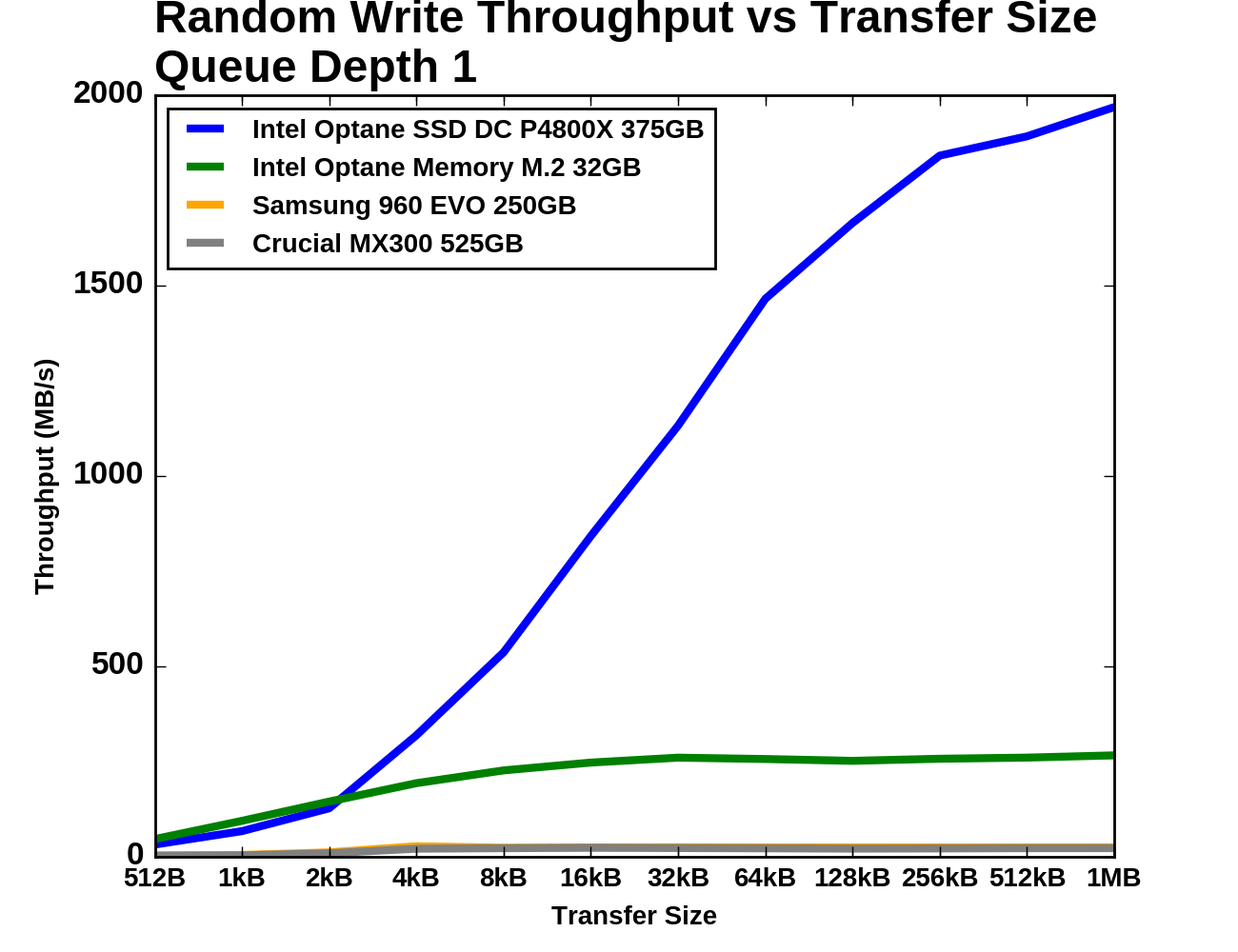 |
|||||||||
| Vertical Axis scale: | Linear | Logarithmic | |||||||
As with random reads, the Optane Memory holds a slight advantage over the P4800X for the smallest transfer sizes, but the enterprise Optane drive completely blows away the consumer Optane Memory for larger transfers. The consumer flash SSDs perform quite similarly in this steady-state test and are consistently about an order of magnitude slower than the Optane Memory.
Queue Depth >1
The test of 4kB random write throughput at different queue depths is structured identically to its counterpart random write test above. Queue depths from 1 to 16 are tested, with up to four threads used to generate this workload. Each tested queue depth is run for four minutes and the first minute is ignored when computing the statistics.
With the Optane SSD DC P4800X included on this graph, the two flash SSDs are have barely perceptible random write throughput, and the Optane Memory's throughput and latency both fall roughly in the middle of the gap between the P4800X and the flash SSDs. The random write latency of the Optane Memory is more than twice that of the P4800X at QD1 and is close to the latency of the Samsung 960 EVO, while the Crucial MX300 starts at about twice that latency.
 |
|||||||||
| Vertical Axis scale: | Linear | Logarithmic | |||||||
When testing across the range of queue depths and at steady state, the 525GB Crucial MX300 is always delivering higher throughput than the Samsung 960 EVO, but with substantial inconsistency at higher queue depths. The Optane Memory almost doubles in throughput from QD1 to QD2, and is completely flat thereafter while the P4800X continues to improve until QD8.
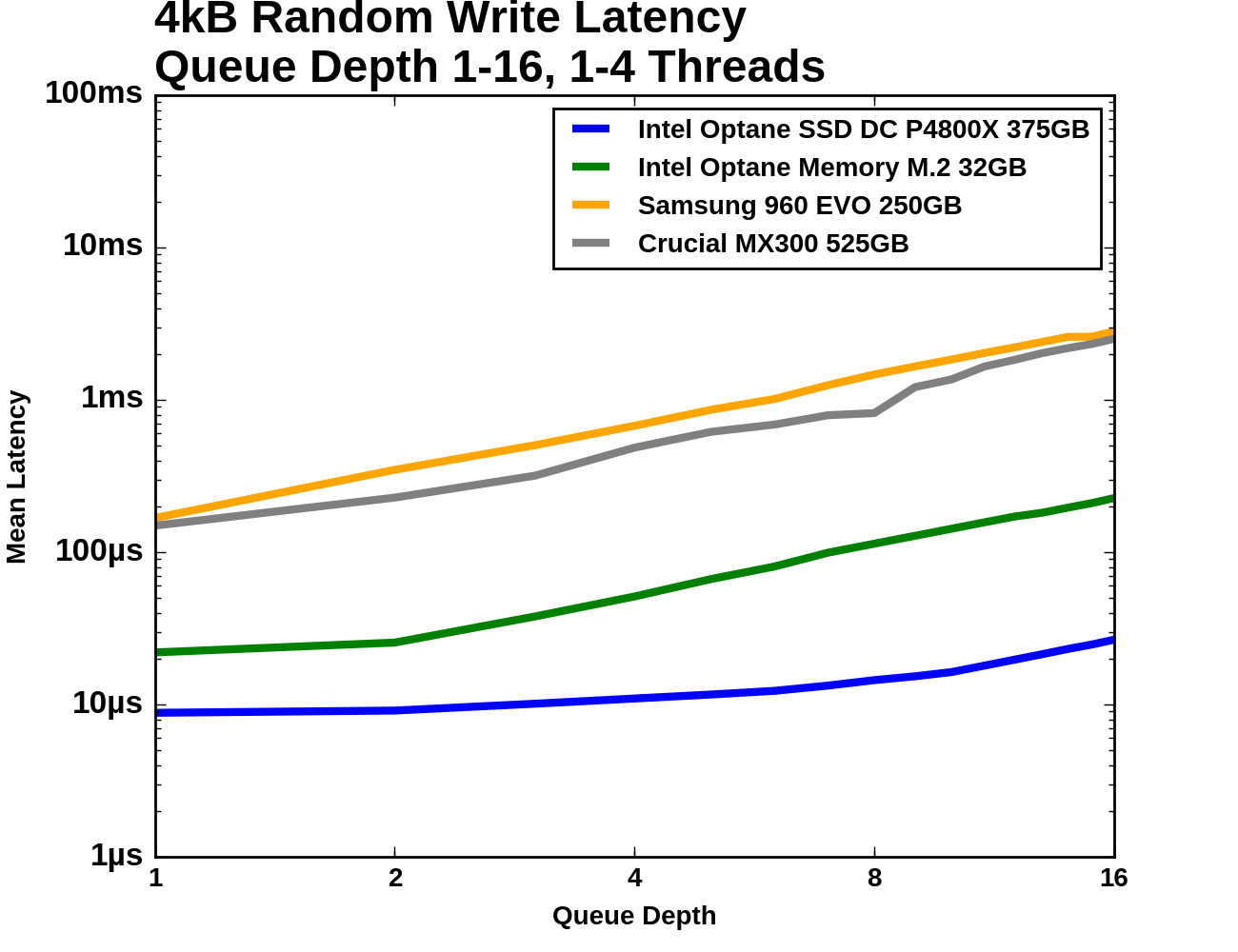 |
|||||||||
| Mean | Median | 99th Percentile | 99.999th Percentile | ||||||
The Optane Memory and Samsung 960 EVO start out with the same median latency at QD1 and QD2 of about 20µs. The Optane Memory's latency increases linearly with queue depth after that due to its throughput being saturated, but the 960 EVO's latency stays lower until near the end of the test. The Samsung 960 EVO has relatively poor 99th percentile latency to begin with and is joined by the Crucial MX300 once it has saturated its throughput, while the Optane Memory's latency degrades gradually in the face of overwhelming queue depths. The 99.999th percentile latency of the flash-based consumer SSDs is about 300-400 times that of the Optane Memory.


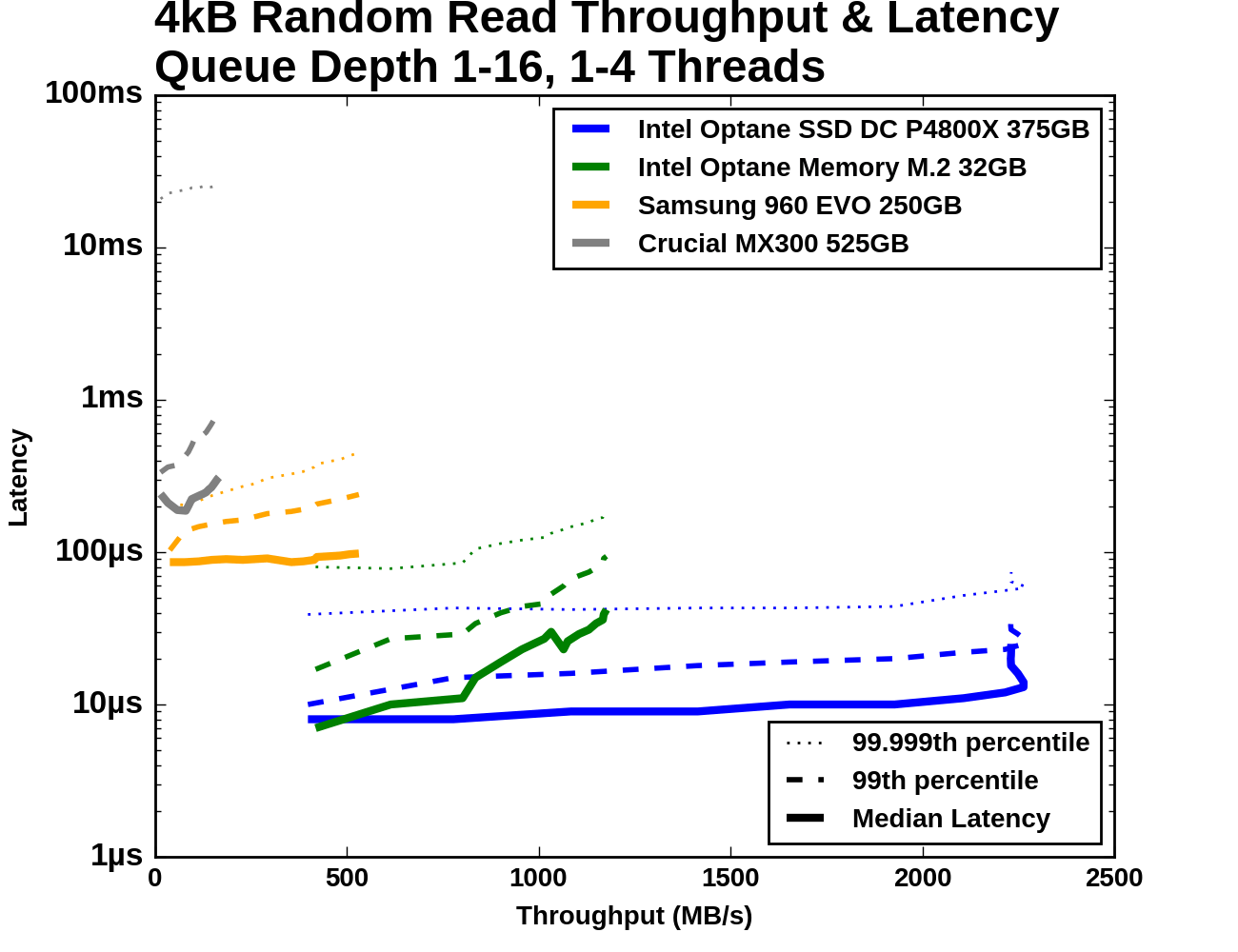
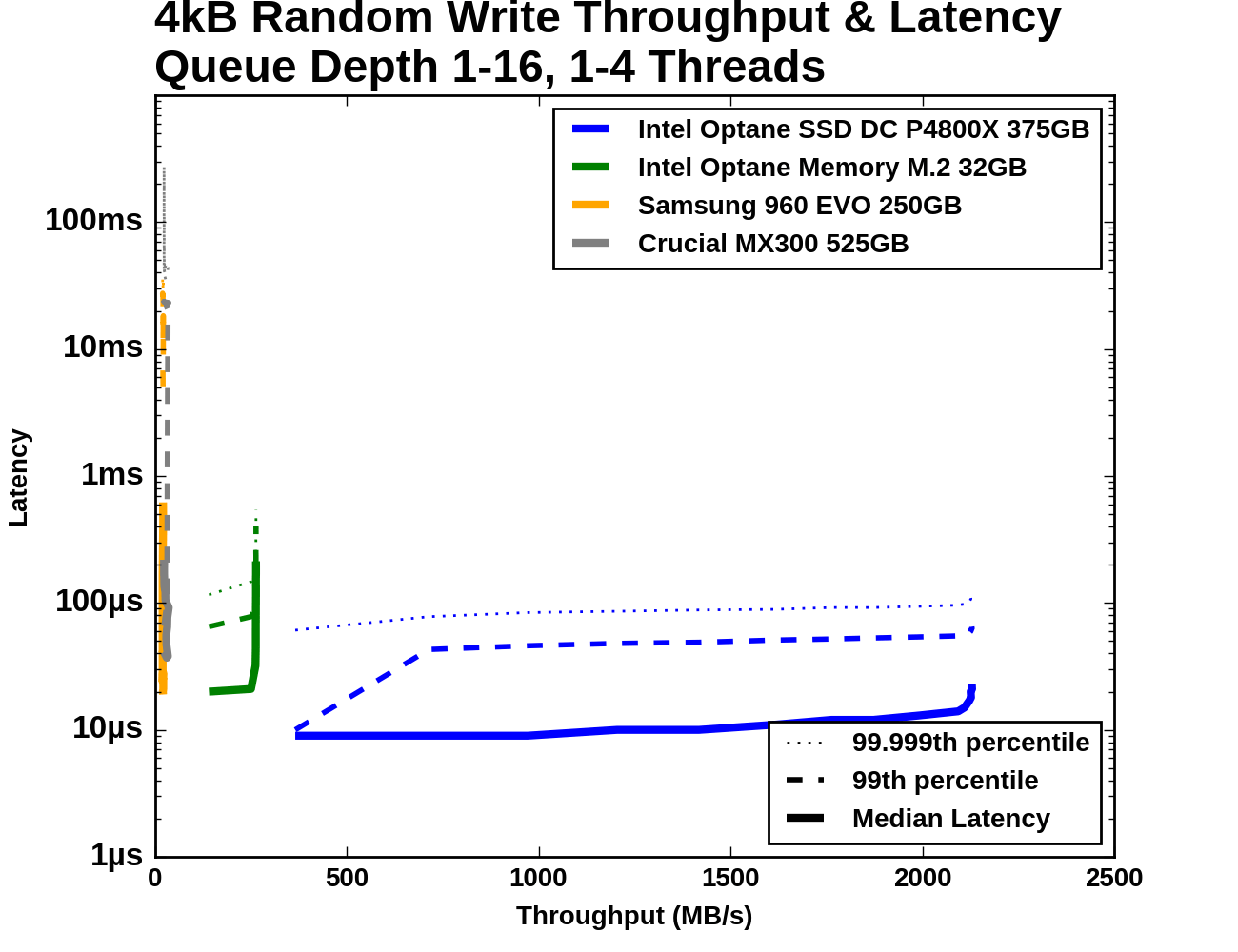








110 Comments
View All Comments
Ratman6161 - Monday, April 24, 2017 - link
"The test that I would be interested in is if this technology could be an effective cache is speeding up mainstream SSDs."That's exactly what I was wondering i.e. if I paired it with my SATA 250 EVO. Or, they have a Crucial MX300 SATA SSD in the test which is an OK lower priced SSD. Given the optane drives are $44 and $77 respectively, if someone had something like the MX300 they might be tempted to pair it with an Optane cache.
On the other hand you have to have the latest Intel CPU and chipset, and I just jumped ship and went with a Ryzen 5 - so its all academic to me.
Lolimaster - Wednesday, April 26, 2017 - link
LTT already did, it's worthless.For $77 you're close of a crucial MX300 275GB
Billy Tallis - Monday, April 24, 2017 - link
That's the test that was running when it died.Twingo - Monday, April 24, 2017 - link
Billy, are you expecting to get a replacement so you can conduct all these tests?Billy Tallis - Monday, April 24, 2017 - link
Yes, the replacement will be delivered tomorrow. But don't expect the follow-up article to be real soon. I also want to update the software on the testbeds and run a reasonably large number of drives through, and do some deeper experimentation with the caching to probe its behavior.beginner99 - Tuesday, April 25, 2017 - link
Mainstream TLC ssds for sure there will be a speed-up measurable in benchmarks. If we as user would actually notice a difference is a completely other question. Due to KISS instead of spending money on this cache drive, instead just buy a tier higher SSD. If mainstrem choose 960 evo instead or of 960 evo choose 960 pro instead.fallaha56 - Tuesday, April 25, 2017 - link
absolutely not(!)for the reason you said
the 960 pro offers no meaningful real-world advantage to anyone / 99.9% of users
Glock24 - Monday, April 24, 2017 - link
"Only Core 13, 15 and i7 processors are supported; Celeron and Pentium parts are excluded."There's a typo or I've never seen those Core 13 and Core 15 CPUs before.
From the data you showed, I see no real benefit is using Optane as a caching solution vs. using an SSD as boot drive. At least not at that price point.
Kristian Vättö - Monday, April 24, 2017 - link
For the full review, could you also monitor DRAM usage? 16GB is not really an entry-level setup, so with that much DRAM Intel's software might be caching to DRAM as well like Samsung's RAPID mode, which would inflate the scores.Might also be worthwhile to run at least a couple of the application tests with 4GB/8GB of DRAM to see how things work when caching is done fully by Optane.
Sarah Terra - Monday, April 24, 2017 - link
Also optane's incredibly low latency should be tested for real world benefits